#hms indefatigable
Explore tagged Tumblr posts
Text
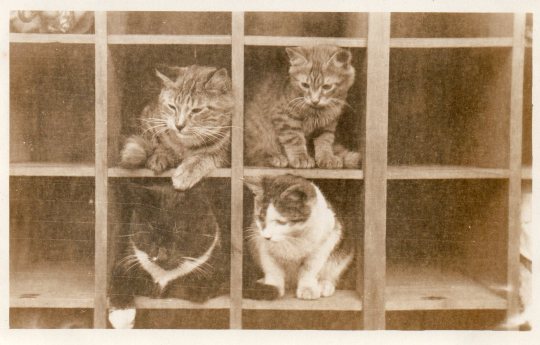
Those are some weird signal flags aboard HMS Indefatigable (1909) - never mind - Hoist the Kitty !
#naval history#ship's cats#flag locker#signal flags#hms indefatigable#early 20th century#ship's cat sunday#age of steam
405 notes
·
View notes
Text

British deck crew ready a Fairey Firefly fighter plane for take from the deck of HMS Indefatigable - Pacific Ocean, Aug 1945
#world war two#ww2#worldwar2photos#history#1940s#ww2 history#wwii#world war 2#ww2history#wwii era#aircraft carrier#1945#pacific ocean#HMS indefatigable#fairey#firefly#aviation
111 notes
·
View notes
Text

The aircraft carrier HMS Indefatigable experiences some choppy seas in the Bay of Biscay, March 1954
19 notes
·
View notes
Text
forgot about the scurvy part of the examination for lieutenant…. terrormaxxing on hms indefatigable
#so caught up in the plague ship and the fire ship i forgot they ended up on the plague ship because everyone was starving#hornblower#and then of course there’s mutiny and retribution….
17 notes
·
View notes
Text

#onthisday in 1944 Captain Eric 'Winkle' Brown lands a Mosquito on HMS Indefatigable. This becomes the first twin-engined British aircraft to land on an aircraft carrier.
@classicwarbirds via X
11 notes
·
View notes
Text
tagged by @terrorsoftheflesh as someone they want to know better 🤍
last song: haunted by laufey
favorite color: pink! 🌷
last movie/tv show: the last performance & the walking dead
sweet/spicy/savory: sweet
relationship status: single
last thing googled: waking up with headache
current obsession: silent movies (i.e. german expressionism i.e. conrad veidt...), old hollywood movies, horror in general, laufey, spending money $$$ apparently!!!!
last book: the merchant of venice
looking forward to: finishing this essay & then withdrawing from the semester..... then reading more perhaps at the local park
3 ships: hms terror, hms erebus, hms indefatigable <3
tagging: @yvain @romanced @no1girl @rozovii @orlaite @oldblood @hauntinghills @milfchellepfeiffer @nymphomaniac20000000
10 notes
·
View notes
Note
Headcanons for Henry from forever (before his 1st death) treating the crew of the Indy from hornblower for sickness or injury?
Thanks for the ask anon! (Sorry this took so long!)
_ Henry's cousin Horatio Hornblower was both his first and one of his most frequent patients on The HMS Indefatigable. He often slunk into the sick berth looking embarrassed and rather frustrated with himself than he had gotten sea sick again. And it wasn't long at all before Henry learned to predict, based on the motion of the ship beneath his feet, when his cousin would come to see him, looking for something to help with the nausea.
_ Henry always tried to console Horatio, tell him he didn't need to be embarrassed about his sea sickness. Plenty of sailors get motion sickness. But Horatio would always reply "not while the ship is still in harbor." and continue sulking. Henry wished he could convince Horatio. He believed it was not only his job to help with the physical ailments of the crew but also their emotional needs when he could. Goodness knows no one else was going to do it.
_On that subject: one of Henry's toughest cases was Midshipmen Archie Kennedy. The man never slept! Henry really wasn't sure what could be done about it, but it was becoming a real issue. He knew it was because of nightmares and had tried to talk to Archie about it, but Archie always brushed him off and pushed him away, claiming he was fine. Henry wished he knew better how to help with the panic attacks.
_ Another frequent flyer was Styles. He was always doing something dumb and reckless that ended with a visit to Henry. It was usually minor injuries that only required some small bandages or a little plaster. Unfortunately, there was no cure for stupid, and yes, Henry had tried.
_ Henry is incredibly fond of his crew of idiots. Pellew may be Captain Dad, but Henry is the protective mother hen who will always wish he could do more for them. He wishes they'd stop throwing themselves into dangerous situations and start taking better care of themselves.
#thanks for the ask!#forever/hornblower crossover#I'm loving all these forever/Hornblower asks! seriously anon thank you so much!#cuz now im having all sorts of feelings about Henry and Horatio being cousins and childhood friends! and honestly it's wonderful!#has it been the same anon every time?
2 notes
·
View notes
Note
book ask 17!
17. Did any books surprise you with how good they are?

I was expecting The Rules of the Game to be good, but it was better than that. Going into it, I had watched Drachinifel's Jutland series and read Castles of Steel, and both took a pretty similar line, 0.9 pro-Jellicoe and 0.1 pro-Beatty. Drach really hates Beatty.
TRotG's stance is effectively, "The long calm of naval dominance after Trafalgar allowed the Royal Navy to ossify into an organization of men obsessed with discipline and following orders, such as one John Jellicoe. Whatever you think of Beatty, he used a loose and aggressive command style more suitable for actual combat in visibility and signalling-limited environments."
His long social history of the Navy in the 1800s explains several odd patterns. Hugh Evan-Thomas not turning to follow the Battlecruisers right off the bat, or the bizarrely passive behavior of RN captains in the night action, where the entire High Seas Fleet barges its way through their line without anyone managing to get a signal off about it, seem like odd blips at first glance. After TRotG you get that they think "do exactly what you're told, nothing more, nothing less," reinforced by the fallout of the Victoria-Camperdown collision. He states directly that for Jellicoe to be faultless, then the only thing that could have gone wrong at Jutland were technical issues (of which there were many) and individual mistakes. And that can't be.

(Technical Issues: HMS Indefatigable exploding at Jutland)
HOWEVER, Beatty has both an extremely sloppy record, and his "loose, initiative-focused" style credentials are severely overstated. Gordon never brought up Beatty trying to micromanage the Battle of Dogger Bank after HMS Lion was crippled and fell behind the rest of the BCS, causing them to all tear off after poor SMS Blucher rather than pursue Hipper. His fuckups are many:
leaving the Queen Elizabeth's, the slowest capital ships under his command, at the rear of his formation
not meeting with Hugh Evan-Thomas to tell him how the BCS does things after the Fifth Battleship Squadron gets assigned to it
his substantial part in the signalling issues that left them behind
his substantial part in the signalling issues that told them to go straight into the High Seas Fleet
aformentioned micromanagement at Dogger Bank
keeping Seymour around in general
his part in the BCS' abysmal ammunition-handling practices (lower-confidence on this, they were in the Grand Fleet too IIRC)
Most of these are mentioned in the book. Evan-Thomas was no genius and Grand Fleet signalling practices were unsuitable, but Beatty's failure in point 2 to tell him what the "rules of the game" actually are in the Battlecruiser Fleet makes him assuming Grand Fleet rules are in place reasonable, and nudges more blame weight onto Beatty.
All in all, my take on Beatty is that he was essentially a moron with the right idea, while Jellicoe was a very technically capable practitioner of a dead-end doctrine.
10 notes
·
View notes
Text

Today we have door 13 and then Friday the 13th. So that we don't get any problems or bad luck today we have the Bloddy Indy to provide some help we also know her as HMS Indefatigable aka Etoile de Roy.

More about her:
The Etoile de Roy, formerly the Grand Turk, is a replica of an 18th century English three-masted frigate of the 6th class, better known as the HMS Indefatigable from the TV series Hornblower. However, the historic Indefatigable was a much larger ship. In the same TV series, the Etoile de Roy appeared as the French ship Papillon. It was mainly built for the international film and television industry.
Today, the tall ship is mainly used for windjammer parades, for chartering by companies or private individuals and for social events in the spacious saloon or on deck. On 28 June 2005, she represented HMS Victory, Nelson's flagship, at the International Fleet Review off Portsmouth to mark the 200th anniversary of the Battle of Trafalgar.
#naval history#naval artifacts#etoile de roy#grand turk#hms indefatigable#frigate#age of sail#replica#hornblower#advent calendar#day 13
77 notes
·
View notes
Text
The Boundless Sea
Sydney
11 June 2023
We headed into Sydney at about 9am this morning with a fairly full raft of activities.
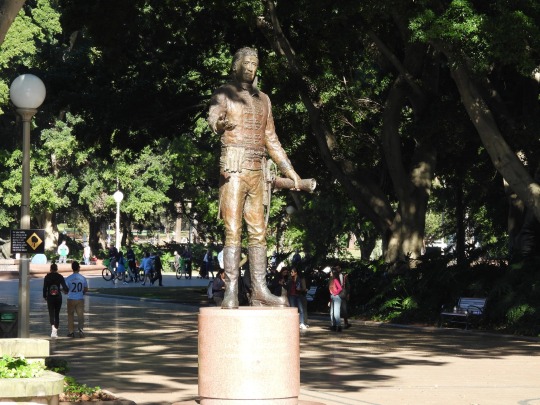
The first of these, which we arrived to at 10, was the Hyde Park Convict Barracks. This barracks was built by order of Governor Lachlan Macquarie in 1817, and today a statue of him stands across the road from the building, gesturing towards it. I can’t help but wonder if Macquarie would appreciate the somewhat dodgy statue of himself showing off the prison he built, but maybe that’s just me. Hyde Park Barracks is a thoroughly modern museum, in that it uses audio guides instead of placards. I generally can’t stand audio guides, but I soon worked out that I could just read the subtitles on the ipod thing they gave us, so it wasn’t a dealbreaker. The museum now includes a major focus on the effects of colonisation and the convict system on the indigenous peoples of New South Wales, which I quite appreciated. The one thing I might have liked more about was a little more information on the guards; but I appreciate that this is specifically a museum about the convicts, not the soldiers.
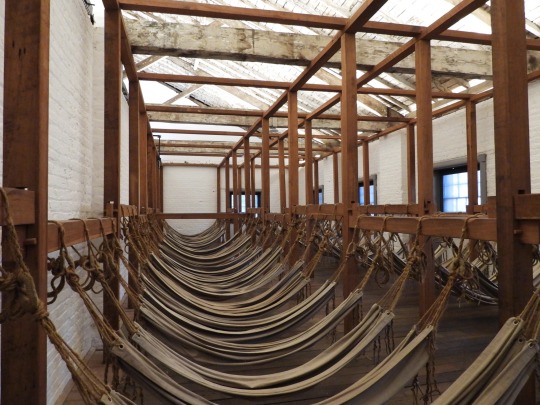
After the barracks, we walked through Hyde Park to the Anzac Memorial. This is Sydney and New South Wales’ primary war memorial, opened in the 1930s to commemorate the First World War. It’s not quite as grand as Melbourne’s Shrine of Remembrance - few things are - but it is still a magnificent structure and well worth a visit. The statue of the prostrate man in the Hall of Silence - positioned under the Hall of Memory, and visible through a hole in the floor which they call the Well of Contemplation - is particularly striking. Most war-related sculptures, at least in the post-WWI period, tend to be horizontal. Here, the prostrated man is vertical - the language of mourning.
Behind the Hall of Memory and down the stairs is the Hall of Service. The walls here are lined with soil samples from every town in New South Wales that has sent soldiers to war. There’s a circle on the floor, under a skylight, with more soil - these from the battlefields on which soldiers from New South Wales have fought. This goes as far back as the New Zealand Wars of the 1860s, but frontier conflict isn’t represented.
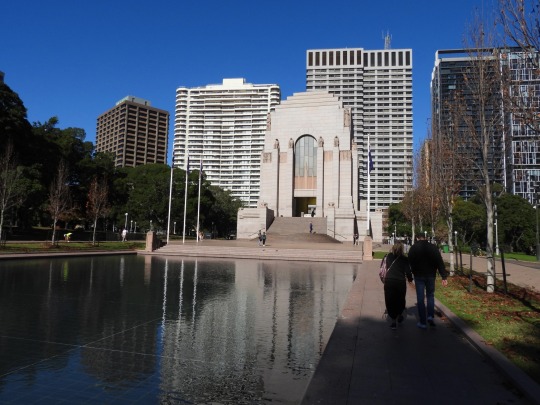
After visiting the Anzac Memorial, we proceeded by train to Circular Quay, and after stopping for a quick drink, caught the Manly Ferry out to Manly. This took us past the Martello tower at Fort Denison, upon which a young Charles Lightoller raised the Boer flag as a prank in the early 1900s, and the naval base at Garden Island. Both Canberra-class helicopter carriers were in port - these are the largest warships Australia has operated since the decommissioning of the carrier HMAS Melbourne. On the port side of the ferry, as one approaches the heads, the foremast of the cruiser HMAS Sydney (the first one) can be seen on the shore. To starboard, one can gaze out through the heads to the Pacific - from here, the sea is almost unbroken until you reach South America.
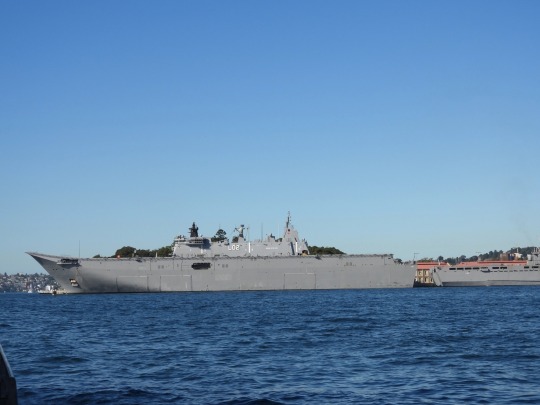
It is somewhere northeast of here that HMAS Australia lies on the seabed, decommissioned and scuttled under the terms of the Washington Naval Treaty. Australia was a battlecruiser - the same class as the unfortunate Indefatigable. She missed Jutland due to damage from a collision with the third member of the class, HMS New Zealand, and thus never saw a major combat action. Her existence, however, deterred German raiders from sailing too close to Australia during the war (although I’d argue that it was actually the entry of the Japanese into the war that really coerced the Germans into fleeing the Pacific altogether.)
We lunched in Manly, and I took a look at the war memorial there - possibly Australia’s oldest, erected before the war had even ended in 1916. I had a look at the beach, too, but it was absolutely packed. We caught the ferry back at around 3pm, and then returned to Hurstville by train.
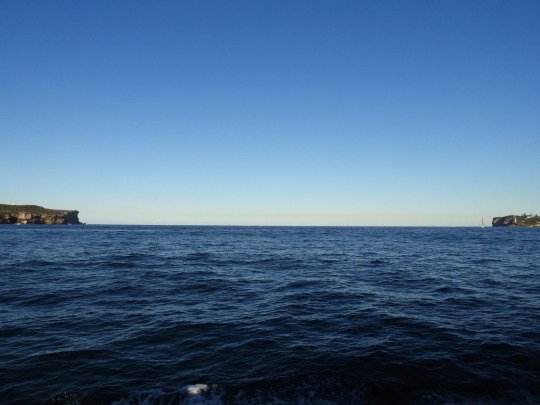
The real journey begins tomorrow - we leave early for Sydney airport, and then we have the long, long flight via Bangkok to Heathrow. This will be a long undertaking, but I’m not certain there will be much to write about - but I shall make a valiant effort regardless.
#second world war#first world war#war#anzac memorial#sydney#hmas canberra#royal australian navy#convicts#cw colonialism
9 notes
·
View notes
Text

Royal Marines Passing HMS Indefatigable, Melbourne 1948.
2 notes
·
View notes
Text
ok i know the tournament hasnt even started (and i'm trying to see if i can fit in the new suggestions) but what if after this i run another one about the boats themselves... like the HMS Surprise vs Indefatigable vs the Walrus... like... what if...
11 notes
·
View notes
Text
Joseph Antonio Emidy and The Music We Lost
"This remarkable man was the most finished musician I ever heard of, though I have had the privilege of listening to most of the stars who have appeared on the London stage during the past fifty years, but not one of them in my estimation has equalled this unknown negro." -William R. Tuck on Joseph Emidy
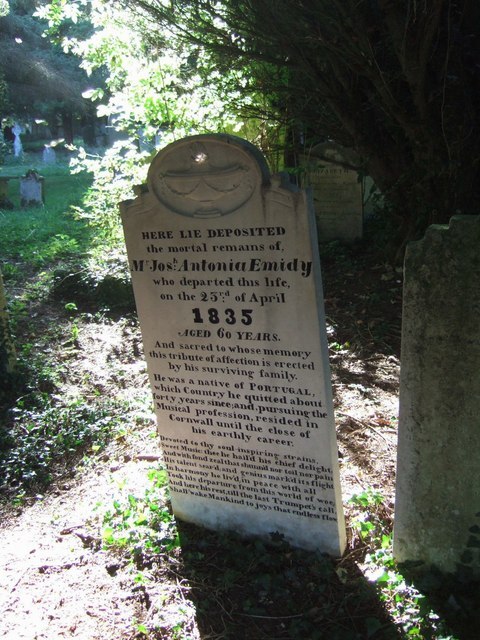
Read on after the cut:
Born somewhere around the year 1775 in Guinea and sold to Portuguese slavers as a child, Joseph was first taken to Brazil and then to Lisbon, Portugal. His owner recognized his musical talents and sought to cultivate them by providing Joseph with violin lessons from a professional musician. In a short three or four years, he was proficient enough to be playing in the second violin section of the pit orchestra for the Lisbon Opera. As someone who plays violin, I have to point out that violin has one of the toughest technical learning curves for a beginner, and to be playing professionally after only four years of serious lessons is impressive AF. He was still enslaved at this time, a fundamentally unjust situation to be in, but it seems at the least that he was allowed to flourish musically.
Enter Sir Edward Pellew, captain of the HMS Indefatigable. At the outset of the French Revolutionary Wars, the Indefatigable met up with the Tagus in the port of Lisbon and the officers went ashore to attend the opera before sailing into the Mediterranean. While there, Emidy seems to have caught Pellew's eye, perhaps because he may have been the only black violinist in the second violin section.
Pellew was aware that fighting the French was going to be a years-long campaign, and that his men would be badly in need of something to help bolster their morale along the way. Thus, by the end of the concert he had directed his men to press-gang Emidy as he left the theater to ensure that they would have a good fiddler to entertain them on ship during the war.
So when you hear about crews kidnapping musicians just so they could have entertainment on board this is the chief canonical example of just that. And as much as Admiral Pellew is admired for his bravery and cunning throughout his career, I can't help but see the flip side of that same mindset, the part that was okay with casually kidnapping someone from an orchestra on the coldly calculated basis that he would be the least likely to be missed.
For approximately four years Emidy served in the Royal Navy as the crew's chief source of onboard entertainment, playing the fiddle for them so they could dance in the evenings. He was not allowed shore leave from the HMS Indefatigable during the entirety of that time, because he was openly miserable about his situation and they feared he would abscond at the first opportunity. Who can blame him? At last, in 1799 Pellew received a commission for the Impetueux. Seeing that he couldn't keep his fiddler much longer, he discharged Emidy at the docks of his home base in Falmouth, Cornwall.
Emidy became an integral part of Cornwall's music circuit, performing regularly at concerts, theatres, and assemblies in various parts of the county, in addition to giving music lessons. He wrote numerous compositions which were held in high enough regard locally that a young James Silk Buckingham (who had taken music lessons with Emidy) was moved to travel to London in 1807 to present some of them to composer and impresario Johann Peter Salomon and his circle of music professionals. While Salomon was intrigued enough to offer Emidy a chance to come perform in London, others warned that even with his talent he would face an uphill battle against the racial prejudices of Londoners. In Cornwall, they argued, at least he was already well-known and well-liked. Ultimately, he remained in Cornwall.
This London meeting happened at about the same time that violin virtuoso George Bridgetower was elected to the Royal Society of Musicians and began working towards his bachelor's in music at Trinity Hall, Cambridge. Perhaps Bridgetower was given more of a pass by London society because he was mulatto, and because of his (somewhat alleged) noble lineage. Emidy was wholly of African descent and a former slave. His abilities had the potential to pose uncomfortable questions to an English society newly grappling with the issue of abolition (the first Abolition Act, which banned the direct purchase of enslaved people from Africa, was passed right in 1807). If nothing else, this experience made an impression on Buckingham, who went on to become an ardent abolitionist and social reformer. On Emidy, Buckingham wrote, "With the same advantages as were enjoyed by most of the great composers of Europe, this man might have become a Mendelssohn or Beethoven; but as it was, it was the achievement of extraordinary perfection, in spite of a thousand obstacles or difficulties."
Emidy lived the rest of his life in Cornwall, making his round of gigs, teaching, and composing. He married Jenefer Hutchins in 1802 and the couple went on to have at least six children (some sources say eight). He died in 1835 at the approximate age of 60, and is buried in Kenwyn Parish Church in Truro.
Several different sources attest to a variety of compositions that Emidy wrote over the course of his career, including chamber music, symphonies, a horn concerto, and several pieces for violin. None of these pieces have been found, at least not yet. It's not so unusual for the time to have no trace of a composer's works, as there was no concerted effort to preserve music that was going out of fashion (and musical tastes changed quite rapidly during this period). But it is extremely disappointing that someone didn't hold onto this music, especially since it seems to have garnered some high praise.
9 notes
·
View notes
Text

While deck crew dive for cover, a British Pacific Fleet Seafire takes out a TBM Avenger and a Fairey Firefly during a landing accident aboard HMS Indefatigable in April 1945.
14 notes
·
View notes
Text
i think it’s funny when it’s busy on hms indefatigable and the gay navy lieutenants and army majors get bitchy
#dropping subtle hints that i’m rewatching the frogs and the lobsters#the horatio edrington archie diva off#until they are united by their mutual dislike of moncoutant and decide instead to maximise their joint slay#sorry for phrasing it like this. it will happen again#hornblower
6 notes
·
View notes
